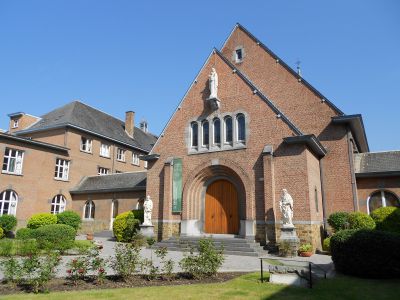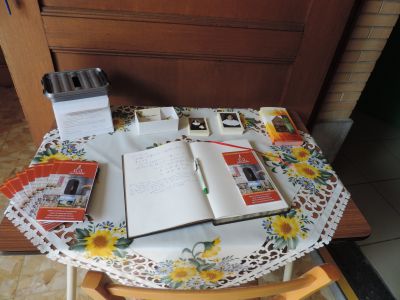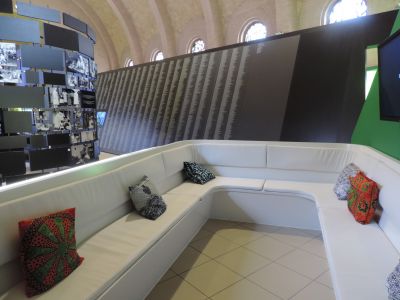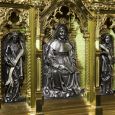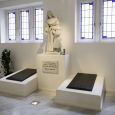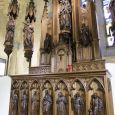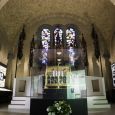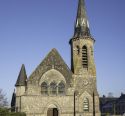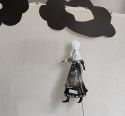Church | 1951 | Modern | Catholic Church


Map
Opening hours
01 January - 31 December
Mon 9.00 - 16.00
Tue 9.00 - 16.00
Wed 9.00 - 16.00
Thu 9.00 - 16.00
Fri 9.00 - 16.00
Sat -
Sun -
We, holidays and groups on reservation :
+32 81 25 43 07 - heritagecentre@sndden.org
Description
The church of Saint Julie is located in the convent of the Sisters of Notre-Dame de Namur. This church was destroyed during the bombardments of 1940 and 1944. It was rebuilt in a modernised Romanesque style. It receives the visit of those who seek a moment of prayer and rest before the shrine of Saint Julie Billiart, founder of the Sisters of Notre-Dame de Namur.
Located in the church, the Heritage Centre of this sister congregation also offers a space for reflection and conversation about the life and spirituality of Julie.
This centre preserves the history of the sister congregation, a teaching monastic community, which has fortresses on all continents. Her founder, Saint Julie Billiart, dedicated her life to education by establishing free schools for young girls who were less fortunate.
This exhibition was conceived in a very modern way to arouse the emotion and interest of the visitors: videos, photos, memories of the beginning and the expansion all over the world of the Congregation, testimonies.
Young and old will be happy to discover this saint from our regions: a woman with a strong character who, just after the French Revolution, worked to create a better world.
Follow us on Facebook!
Photos
Media
Remarkable elements
Shrine of Saint Julie
A pure Gothic work of art, the shrine of Saint Julie Billiart was made by the workshops of M. Dehin in Liège, on the occasion of Julie's beatification on 13 May 1906. The shrine is made of copper gilded with fine gold and contrasting reliefs in silver-plated copper. Each front depicts scenes from Julie's life. On the base, it reads in Latin: The body of Blessed Julie Billiart, placed among the celestials by Pope Pius X on the third of the ides of May 1906, was deposited in this shrine by Thomas Louis Heylen, Bishop of Namur, on the fifth of the ides of April (9th April) of the same year.
Statue of Saint Julie
This fine statue in white Carrara marble was created by the Italian sculptor Tripisciano for the beatification of Julie Billiart. It was placed in 1907 in the chapel in the garden of the Sisters of Notre-Dame de Namur, where Julie Billiart was buried. In 2012, when the Sisters' heritage centre was created, the statue was moved to the convent church.
Oak altar
In the neo-Gothic style, this beautiful oak altar seems to have come out of the same workshop, that of François de Tombay, a sculptor born in Liège (1808-1872). ). Only the Virgin bears a signature on its base: "Fçois De Tombay, sculpteur 1854". The altar contains the relics of the martyred saints: Saint Amand and Saint Clément. Oak statuettes of the great founders of orders evoke the life of the Church in which Julie Billiart's work is inserted: Saint Ignatius, Saint Augustine, Saint Gregory the Great, Saint François de Sales, Saint Norbert and Saint Vincent de Paul.
This wooden altar was originally installed in the garden chapel of the Sisters of Notre-Dame de Namur. After Julie's beatification in 1906, the shrine containing her remains was placed under the altar. In 2012, the altar was moved to the church of Saint Julie.
Vault
The church of the convent of the Sisters of Notre-Dame de Namur was destroyed after the bombings of 1940 and 1944. Mr Rossomme, an architect from Namur, was commissioned to draw up plans for the rebuilding of the congregation's motherhouse. He drew up the plan for the new church, which was soon to be built on the site of the old one. The contractor was Mr Henry, from the Rhodius-Deville firm. Work began in February 1950. The church was rebuilt in a sort of modernised Romanesque style, hence the use of the semicircular arch for the vault. The church was consecrated on 2 August 1951.
Heritage Centre
The Heritage Centre was set up in 2012 in the nave of Saint Julie's Church. It preserves the history of the Congregation of the Sisters of Notre-Dame de Namur through writings, symbols, photos and images from its foundation to the present day. Four themes are developed: the history of Saint Julie and Françoise Blin de Bourdon, founders of the congregation; the expansion of the congregation, the mission and ministries of the Sisters and the spirituality of Saint Julie.
Portrait of Saint Julie Billiart
"In 1813, Mother Julie, yielding to the entreaties of the co-foundress, allowed an artist, Monsieur Jacquin, to fix her features on canvas. Namur and a few houses (the two foundations in Ghent and Gembloux) had originals, copies were reproduced and distributed to all the houses".
The original from Ghent is on display in the church, as the one from Namur burnt down during the bombings of the 2nd World War.


